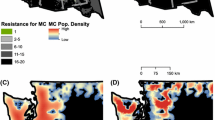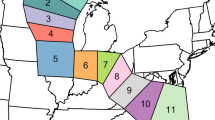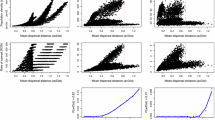Abstract
Simulations of dispersal across computer-generated neutral landscapes have generated testable predictions about the relationship between dispersal success and landscape structure. Models predict a threshold response in dispersal success with increasing habitat fragmentation. A threshold is defined as an abrupt, disproportionate decline in dispersal success at a certain proportion of habitat in the landscape. To identify potential empirical threshold responses in invasion success to landscape structure, we quantified the relationship between progression of the gypsy moth (Lymantria dispar) invasion wavefront across Michigan (1985–1996) and the structure of the Michigan landscape using two indices of invasion success and six landscape metrics. We also examined the effect of scale of analysis and choice of land cover characterization on our results by repeating our analysis at three scales using two different land cover maps. Contrary to simulation model predictions, thresholds in invasion success did not correspond closely with thresholds in landscape structure metrics. Increased variation in invasion success indices at smaller scales of analysis also suggested that invasion success should be studied at larger spatial extents (≥75 km2) than would be appropriate for characterizing individual dispersal events. The predictions of individual dispersal models across neutral landscapes may have limited applications for the monitoring and management of vagile species with excellent dispersal capabilities such as the gypsy moth.




Similar content being viewed by others
Abbreviations
- p crit :
-
Percolation critical threshold, or proportion of habitat at which a disproportionate decline in dispersal success is observed
- p :
-
Proportion of habitat
References
Andren H (1994) Effects of habitat fragmentation on birds and mammals in landscapes with different proportions of suitable habitat: a review. Oikos 71:355–366
Brown JH (1995) Macroecology. The University of Chicago Press, Chicago, Illinois, USA
Collingham YC, Hill MO, Huntley B (1996) The migration of sessile organisms: a simulation model with measurable parameters. J Veg Sci 7:831–846
Collingham YC, Huntley B (2000) Impacts of habitat fragmentation and patch size upon migration rates. Ecol Appl 10:131–144
Doak DF, Marino PC, Kareiva PM (1992) Spatial scale mediates the influence of habitat fragmentation on dispersal success: implications for conservation. Theor Popul Biol 41:315–336
Donovan ML, Nesslage GM, Skillen JJ et al (2004) The Michigan Gap Analysis Project Final Report. Wildlife Division, Michigan Department of Natural Resources, Lansing
Elkinton JS, Liebhold AM (1990) Population dynamics of gypsy moth in North America. Annu Rev Entomol 35:571–596
Gage SH, Wirth TM, Simmons GA (1990) Predicting regional gypsy moth (Lymantriidae) population trends in an expanding population using pheromone trap catch and spatial analysis. Environ Entomol 19:370–377
Gardner RH, Milne BT, Turner MG et al (1987) Neutral models for the analysis of broad-scale landscape pattern. Landsc Ecol 1:19–28
Garnder RH, O’Neill RV, Turner MG et al (1989) Quantifying scale-dependent effects of animal movement with simple percolation models. Landsc Ecol 3:217–227
Hanna M (1981) Gypsy moth (Lepidoptera: Lymantriidae) survey in Michigan. Gt Lakes Entomol 14:103–108
Hunter MD (2002) Landscape structure, habitat framentation, and the ecology of insects. Agricult Forest Entomol 4:159–166
Isaaks EH, Srivastava RM (1989) An introduction to applied geostatistics. Oxford University Press, New York, NY
Isard SA, Gage SH (2001) Flow of life in the atmosphere. Michigan State University Press, East Lansing, Michigan, USA
King AW, With KA (2002) Dispersal success on spatially structured landscapes: when do spatial pattern and dispersal behavior really matter? Ecol Model 147:23–39
Lele S, Taper ML, Gage SH (1998) Statistical analysis of population dynamics in space and time using estimating functions. Ecology 79:1489–1502
Li H, Wu J (2004) Use and misuse of landscape indices. Landsc Ecol 19:389–399
Liebhold AM, Halverson GA, Elmes GA (1992) Gypsy moth invasion in North America: a quantitative analysis. J Biogeogr 19:513–520
Malanson GP, Cairns DM (1997) Effects of dispersal, population delays, and forest fragmentation on tree migration rates. Plant Ecol 131:67–79
Matlack GR, Monde J (2004) Consequences of low mobility in spatially and temporally heterogeneous ecosystems. J Anim Ecol 92:1025–1035
Maurer BA (1999) Untangling ecological complexity: the macroscopic perspective. University of Chicago Press, Chicago
Michigan Department of Natural Resources (1999) Michigan Resource Information System (MIRIS): Land cover interpreted from aerial photography MDNR 1978 Landuse/Cover. MDNR, Lansing, Michigan, USA
Mladenoff DJ, DeZonia B (2002) APACK 2.22 User’s guide
Moody ME, Mack RN (1988) Controlling the spread of plant invasions: the importance of nascent foci. J Appl Ecol 25:1009–1021
Neter J, Wasserman W, Kutner MH (1985) Applied linear statistical models. Irwin, Homewood, Illinois
Newcomb Homan R, Windmiller BS, Reed JM (2004) Critical thresholds associated with habitat loss for two vernal pool-breeding amphibians. Ecol Appl 14:1547–1553
O’Dell WV (1955) The gypsy moth outbreak in Michigan. J Econ Entomol 48:170–172
O’Neill RV, Milne BT, Turner MG et al (1988) Resource utilization scales and landscape pattern. Landsc Ecol 2:63–69
Pitelka LF (1997) Plant migration and climate change. Am Sci 85:464–473
Qian SS, King RS, Richardson CJ (2003) Two statistical methods for the detection of environmental thresholds. Ecol Model 166:87–97
Schwartz MW (1992) Modelling effects of habitat fragmentation on the ability of trees to respond to climatic warning. Biodivers Conserv 2:51–60
Sharov AA, Leibhold AM (1998) Model of slowing the spread of gypsy moth (Lepidoptera: Lymantriidae) with a barrier zone. Ecol Appl 8:1170–1179
Sharov AA, Pijanowski BC, Liebhold AM et al (1999) What affects the rate of gypsy moth (Lepidoptera: Lymantriidae) spread: winter temperature or forest susceptibility? Agricult Forest Entomol 1:37–45
Shigesada N, Kawasaki K, Takeda Y (1995) Modeling stratified diffusion in biological invasions. Am Nat 146:229–251
Taylor RAJ, Reling D (1986) Density/height profile and long-range dispersal of first-instar gypsy moth (Lepidoptera: Lymantriidae). Environ Entomol 15:431–435
Wiens JA, Milne BT (1989) Scaling of ‘landscapes’ in landscape ecology, or, landscape ecology from a beetle’s perspective. Landsc Ecol 3:87–96
Wiens JA, Schooley RL, Weeks RD Jr (1997) Patchy landscapes and animal movements: do beetles percolate? Oikos 78:257–264
With KA (2004) Assessing the risk of invasive spread in fragmented landscapes. Risk Analysis 24:803–815
With KA, Crist TO (1995) Critical thresholds in species’ response to landscape structure. Ecology 76:2446–2459
With KA, King AW (1999) Dispersal success on fractal landscapes: a consequence of lacunarity thresholds. Landsc Ecol 14:73–82
Yang D, Pijanowski BC, Gage SH (1998) Analysis of gypsy moth (Lepidoptera: Lymantriidae) population dynamics in Michigan using geographic information systems. Environ Entomol 27:842–852
Acknowledgements
The authors thank M. Wilberg, M. Jones, R. Kobe, and for constructive advice and careful review of this manuscript. Funding was provided in part by the Graduate School and the Ecology, Evolutionary Biology, and Behavior Program at Michigan State University.
Author information
Authors and Affiliations
Corresponding author
Rights and permissions
About this article
Cite this article
Nesslage, G.M., Maurer, B.A. & Gage, S.H. Gypsy moth response to landscape structure differs from neutral model predictions: implications for invasion monitoring. Biol Invasions 9, 585–595 (2007). https://doi.org/10.1007/s10530-006-9061-1
Received:
Accepted:
Published:
Issue Date:
DOI: https://doi.org/10.1007/s10530-006-9061-1




